During my every day 15 minutes walk down to take the bus to work (the Swiss Ski School St. Moritz) I’m pretty often finding myself listening to podcasts. I just love podcasts. A podcast is simply a series of spoken articles, or audio episodes, all focused on a particular thing (a topic or a theme). I think it is a great way to learn directly from experts about things you are interested in, completely on demand and sometimes even while multitasking. Another benefit of podcasts is that you cut down your screen time. In fact, studies show that the brain is more active while listening to podcasts than when watching television. This is because podcasts require listeners to use their imagination rather than spoon-feeding consumers with visual accompaniment. So for the sake of your eyes and to stimulate your imagination, try to listen to podcasts every day!
That’s how I found a very interesting network called BLISTER Review. An outdoor media company that produces, as they claim, “honest & in-depth gear reviews, podcasts, and more”. On one of their different podcasts, the GEAR30, there is this series of interviews with Matt Manser, the product manager of Atomic Ski Boots. And trust me, every second of it is really worth it.
In a couple of those episodes, they talk about the ski boot’s forward lean angles. A very important yet not very well-known aspect of ski boots.
On my setup I tend to be a “very high degree of forward-lean” kind of guy. I always felt that it really helps me to stay forward, particularly on steeps. If you would remove the rear spoilers in my ski boots, for example, I would rather go to have a nice Swiss Alps fondue but no skiing (at all) for me. Actually, I’ve never liked that new trend of boot manufacturers building their boots with their cuffs in a more “upright” position. That type of boots put me in the backseat easily.
But first things first, what is forward lean? Forward lean is the forward tilt of the upper cuff (shell and liner included) of the boot, which makes the leg tilt forward and stay in good fore-aft balance during a huge range of vertical motion of the skier.
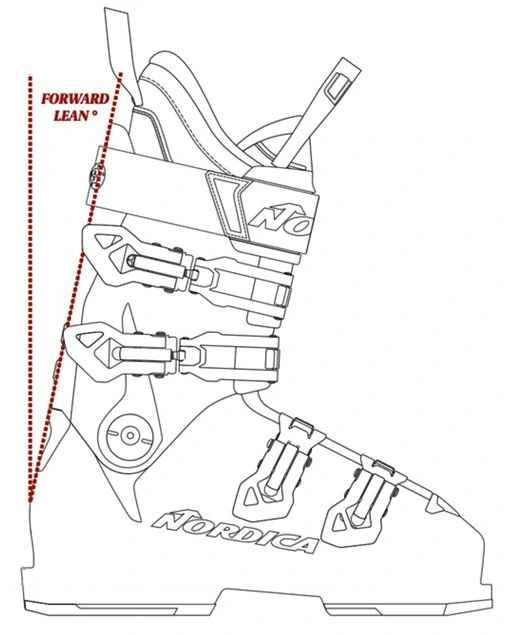
Forward-lean numbers
13-15 degrees is the average medium forward-lean in most commercial ski boots. More upright (13 degrees or less) are commonly found in freestyle ski boots. But, on the opposite, racing boots have aproximately 17 degrees of forward lean, or even more in WC athletes.
Something interesting that Matt Manser said in the interview is that most people tend to be really amazed when they find out how much forward lean racers actually use. World Cup athletes tend to use a huge amount of forward lean in their boots. And that goes against the actual trend of boot manufacturers to build boots with a more “upright allaround neutral stance” (12-13 degrees), trying to make ski boots “more confortable”, but definitely decreasing the performance (from my perspective).
For example, Marcel Hirscher, the most successful ski racer of all time used this setup: 18 degrees of boot’s cuff forward-lean, plus cuff spoilers mounted into the cuff itself, plus a 5 degrees liner rear spoiler… So that is more than 20 degrees of forward lean… just massive!
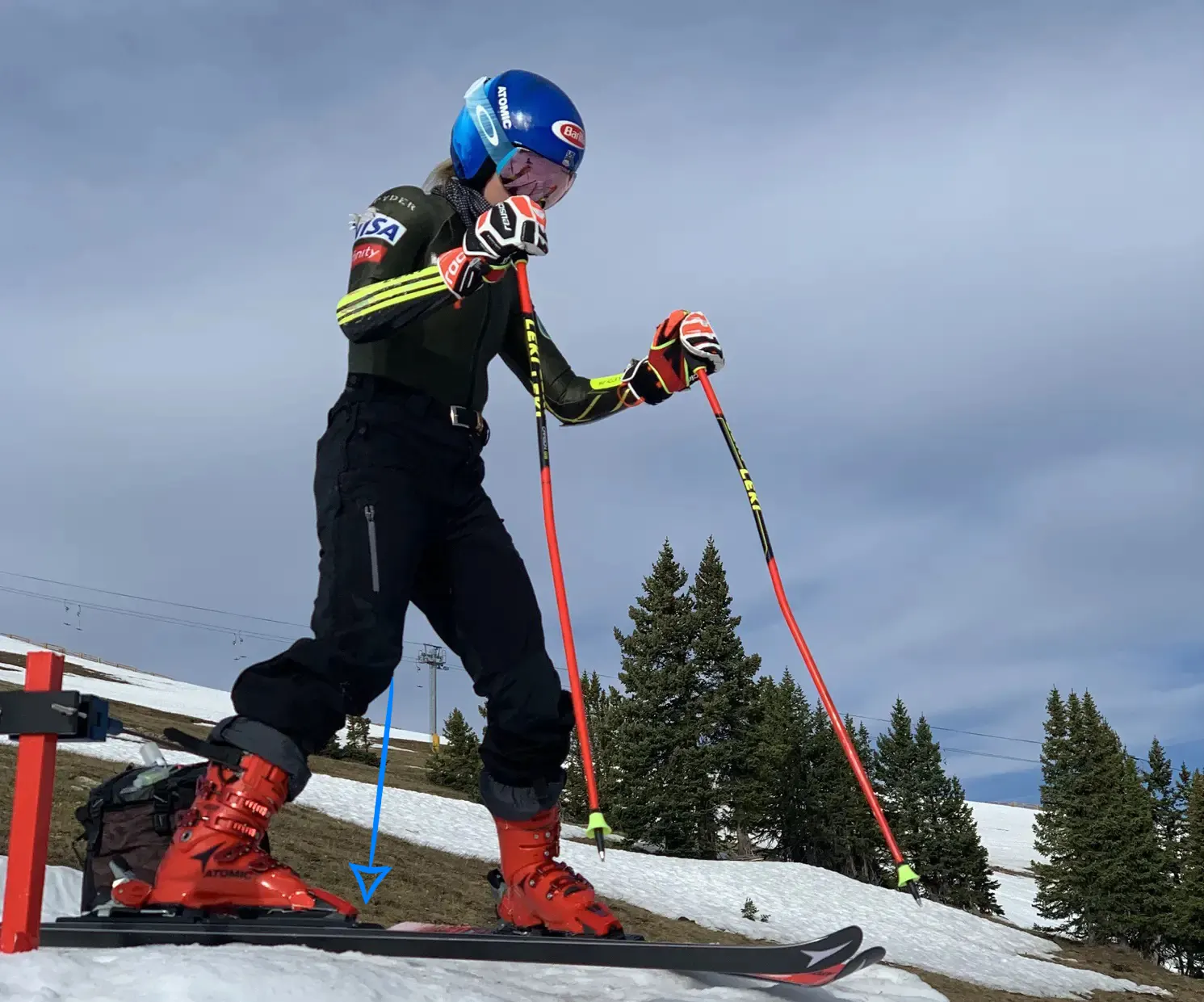
Mikaela Shiffrin training at Copper Mountain, CO, USA. Note again, the amount of forward lean she has in her setup. Note how forward the knee is, over the front binding (blue arrow).
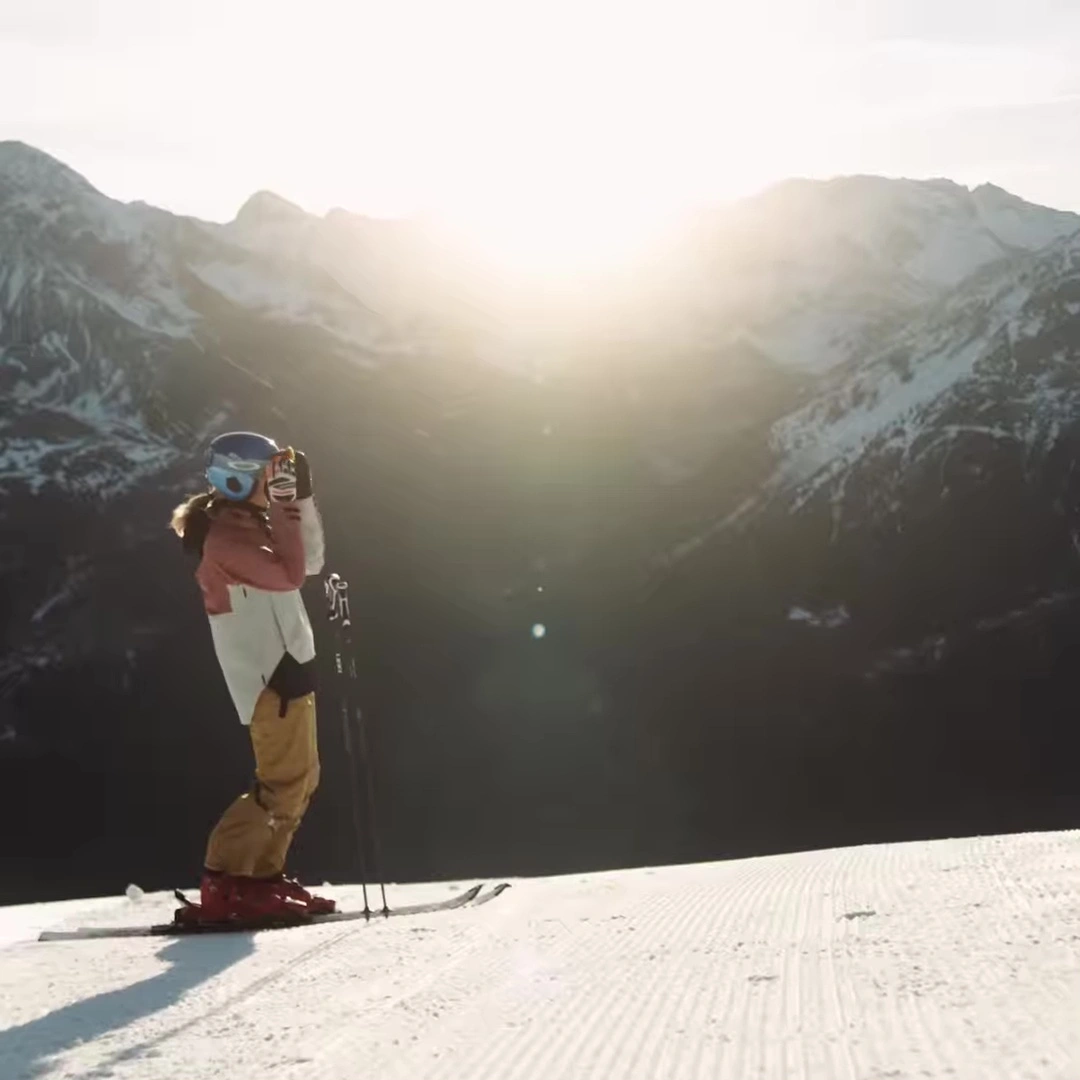
Another picture of Mikaela Shiffrin while she was freeskiing for an ADIDAS Terrex ad. Look how her knees are way forward, actually over the front binding.
Furthermore, quite a few of professional freeride skiers use racing (and racing-style) ski boots with lots of forward-lean to perform on the steep and wild descents they do.
It is quite the norm that the steeper the terrain (on a race course or off-piste), the more forward-lean the athletes request, in order to help them keep forward on their skis.
But, very important: that doesn’t mean high forward lean angles are good for everybody. If the skier has limited ankle dorsiflexion, high forward lean can be disastrous. Many skiers lack the sufficient range of ankle flexion (“dorsiflexion”) to even fit into a boot with a lot of forward lean, and attempting to do so can cause severe problems (heel lifting, aquiles tendon injuries, etc). So please, check it with your local boot fitter before making drastical changes in your setup.
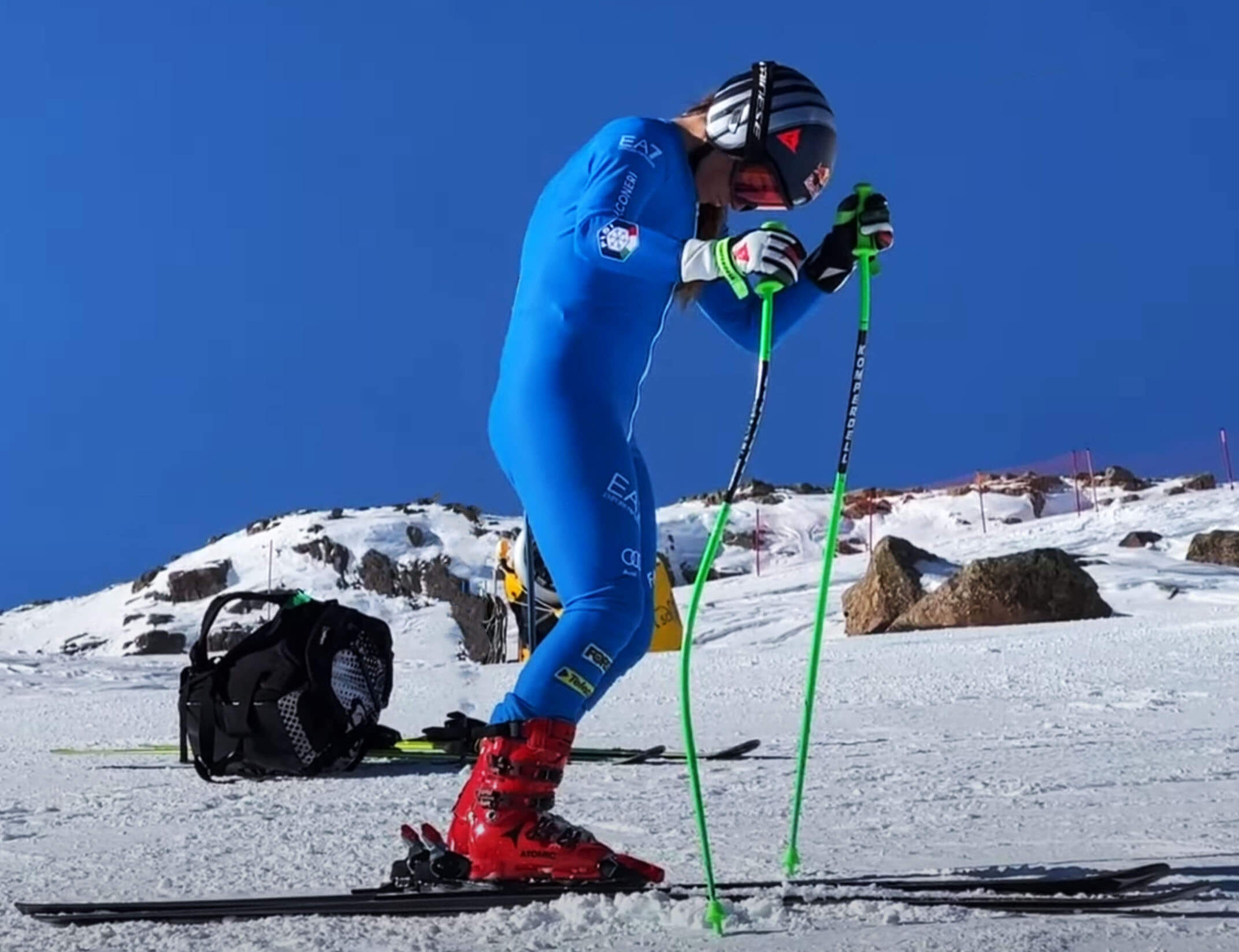
Another great example of the amount of forward-lean World Cup athletes use comes from Sofia Goggia, the Italian legend. In the picture above, you can appreciate how forward her knee is, also over the front binding. This picture is a still frame from a video of her training with Mikaela Shiffrin in San Pellegrino.
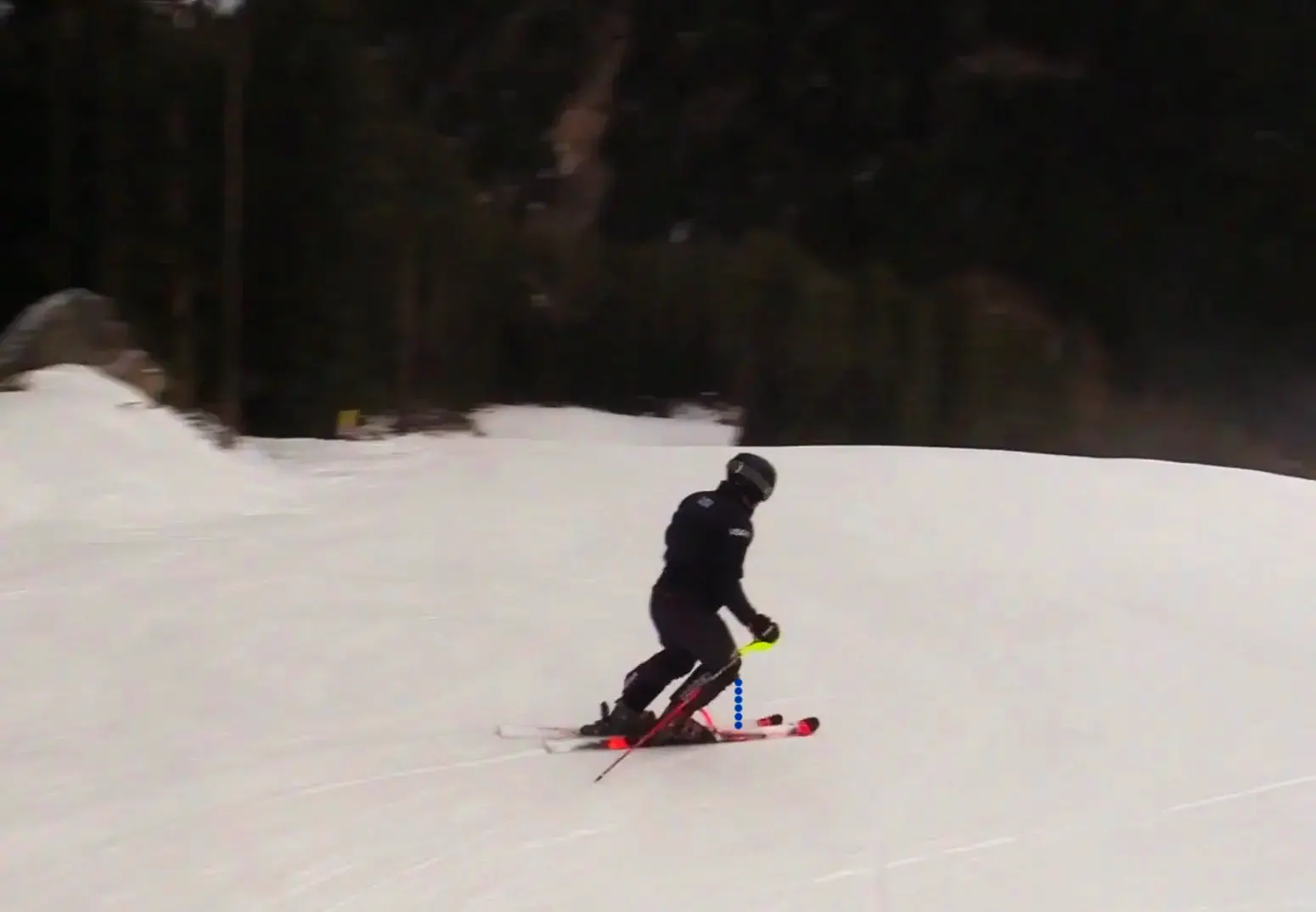
One example more with Jimmy Krupka, a US Ski Team athlete and host of the Arc City Podcast. Note how forward his knees are. Impressve.
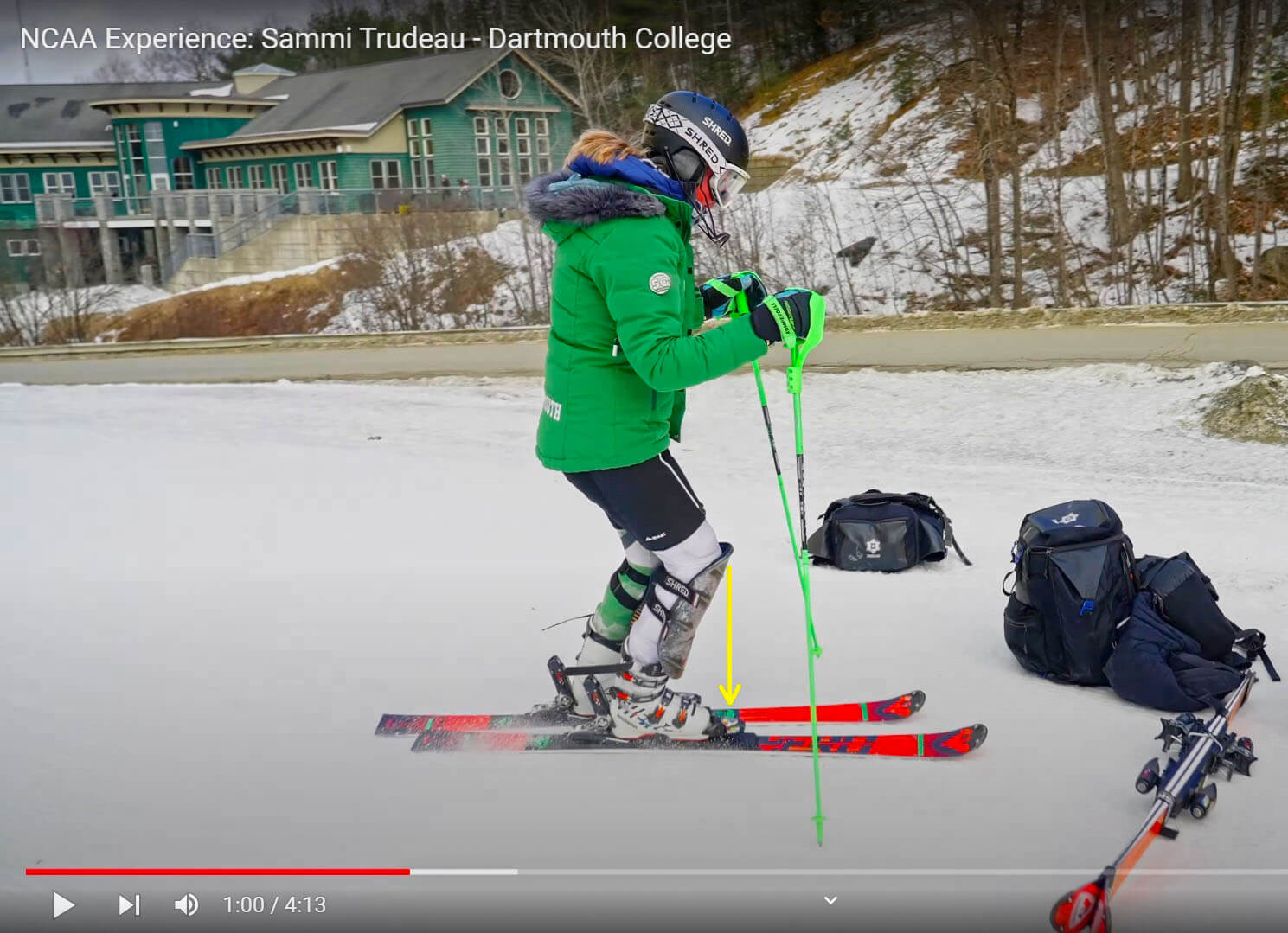
One example more with Darmouth College student-athlete Samantha (Sammi) Trudeau on her Slalom setup.
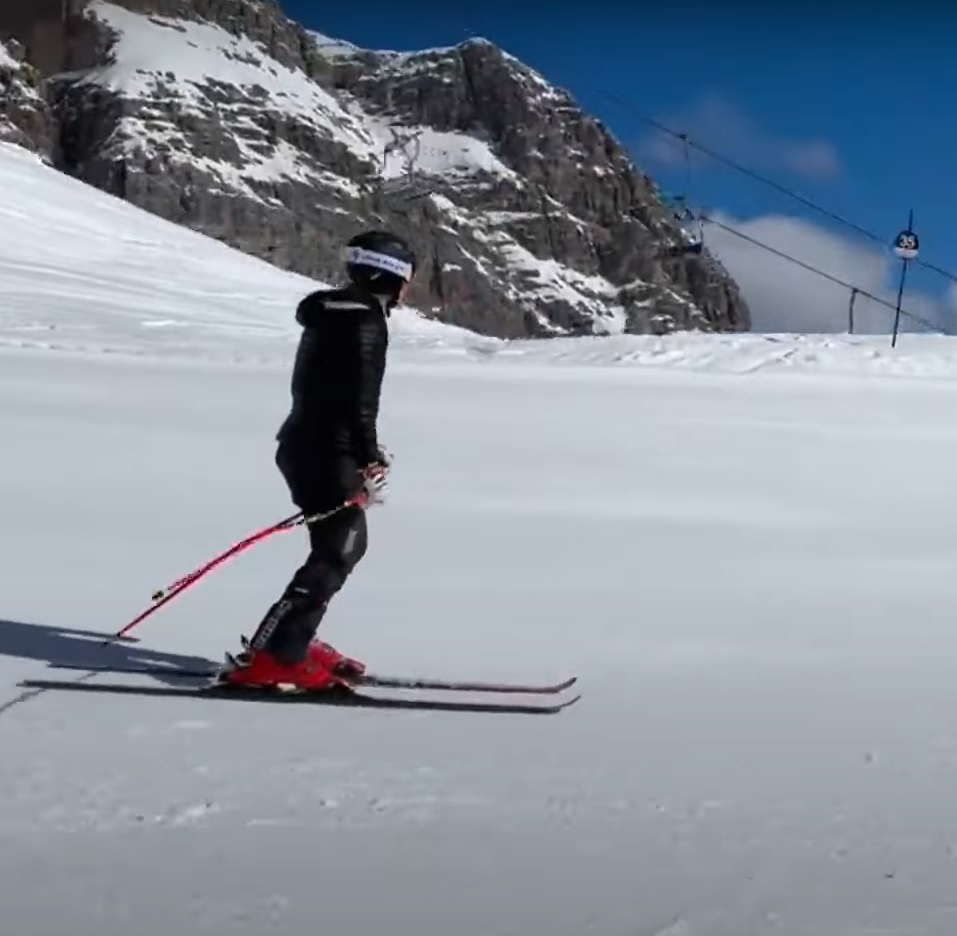
Mikaela Shiffrin freeskiing with GS skis on the Olympia delle Tofane, the classic women’s World Cup downhill ski course in Cortina d’Ampezzo, Veneto region, Italy. Note the amount of forward lean of her boots, and how her torso remains alomst “straight up” when “resting” on the skis and not actually “skiing”.
Forward lean adjustment
Some boots have the possibility of increasing the forward lean, in two possible ways: acting on the liner itself, or acting on the shell.
The usual method is to attach a velcro rear spoiler to the back part of the liner. The lower you attach it to the liner, the more forward tilt you’ll get. This method is not available in every ski boot, but is very common on race plug ski boots (92mm last), and the high-performance “racing style” category (95-96 mm last).
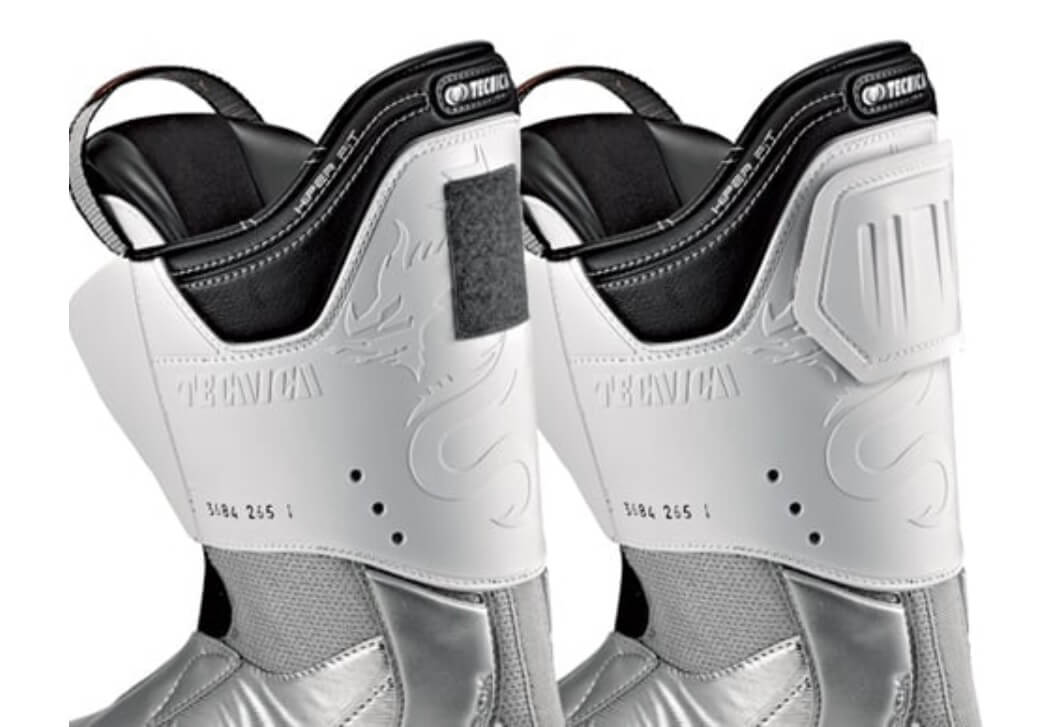
Other ski boots have an adjustment in the back of the cuff’s shell. Sometimes the forward lean is adjusted via T-shaped shims, situated between the cuff and lower shell (like the Atomic Redster’s). Others, like the Fischer’s RC4 GT below, have a plate in the boot’s cuff back spine.
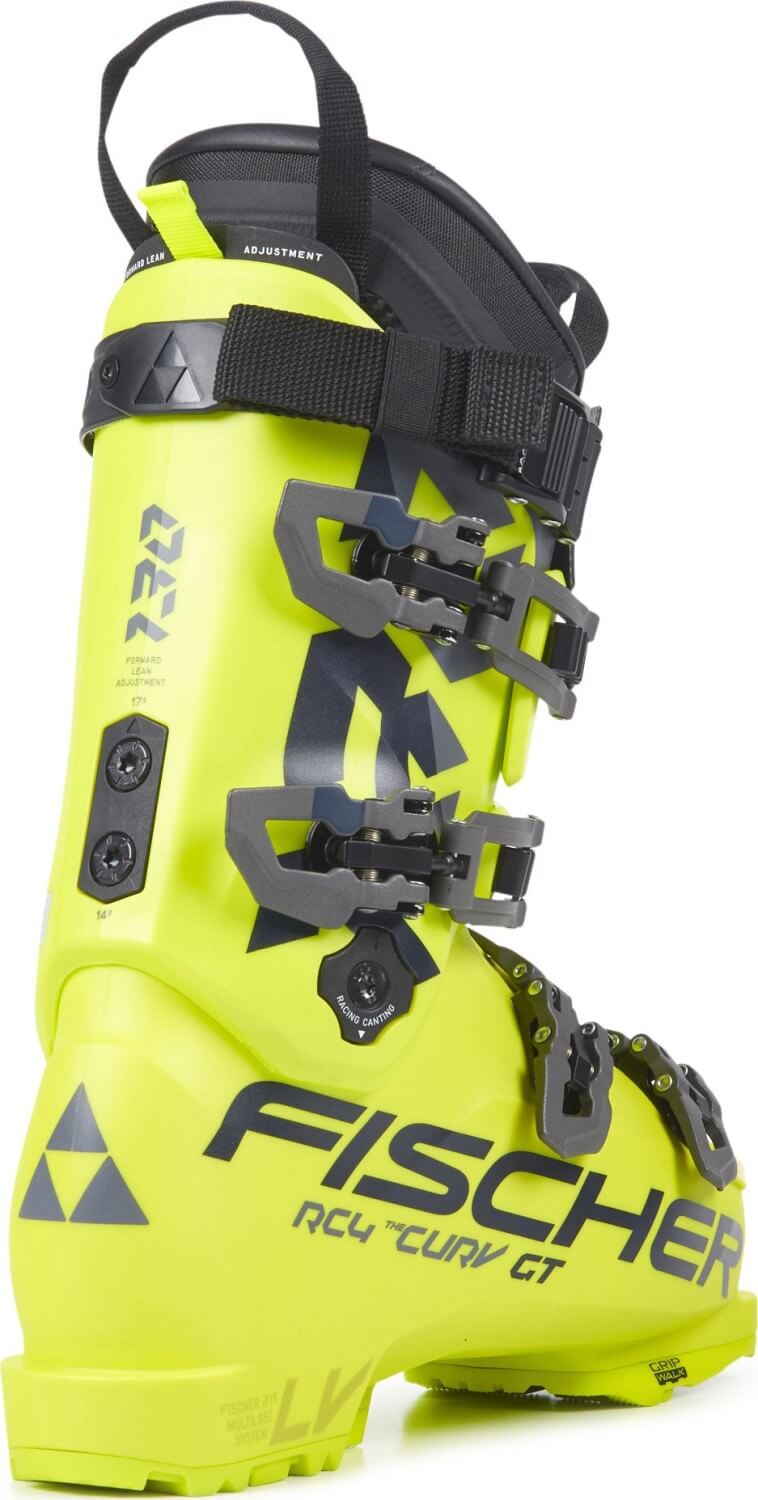
Below is another example of a plastic shim added to the back of the cuff to increase forward lean. This boot belongs to Alexandr Khoroshilov, a former Russian World Cup alpine ski racer specializing in slalom. He gained his first victory in 2015 in the slalom at Schladming and became the first Russian male to win a World Cup race in 34 years since Aleksandr Zhirov of the Soviet Union in 1981. Again, huge forward lean angles are common in the slalom discipline.
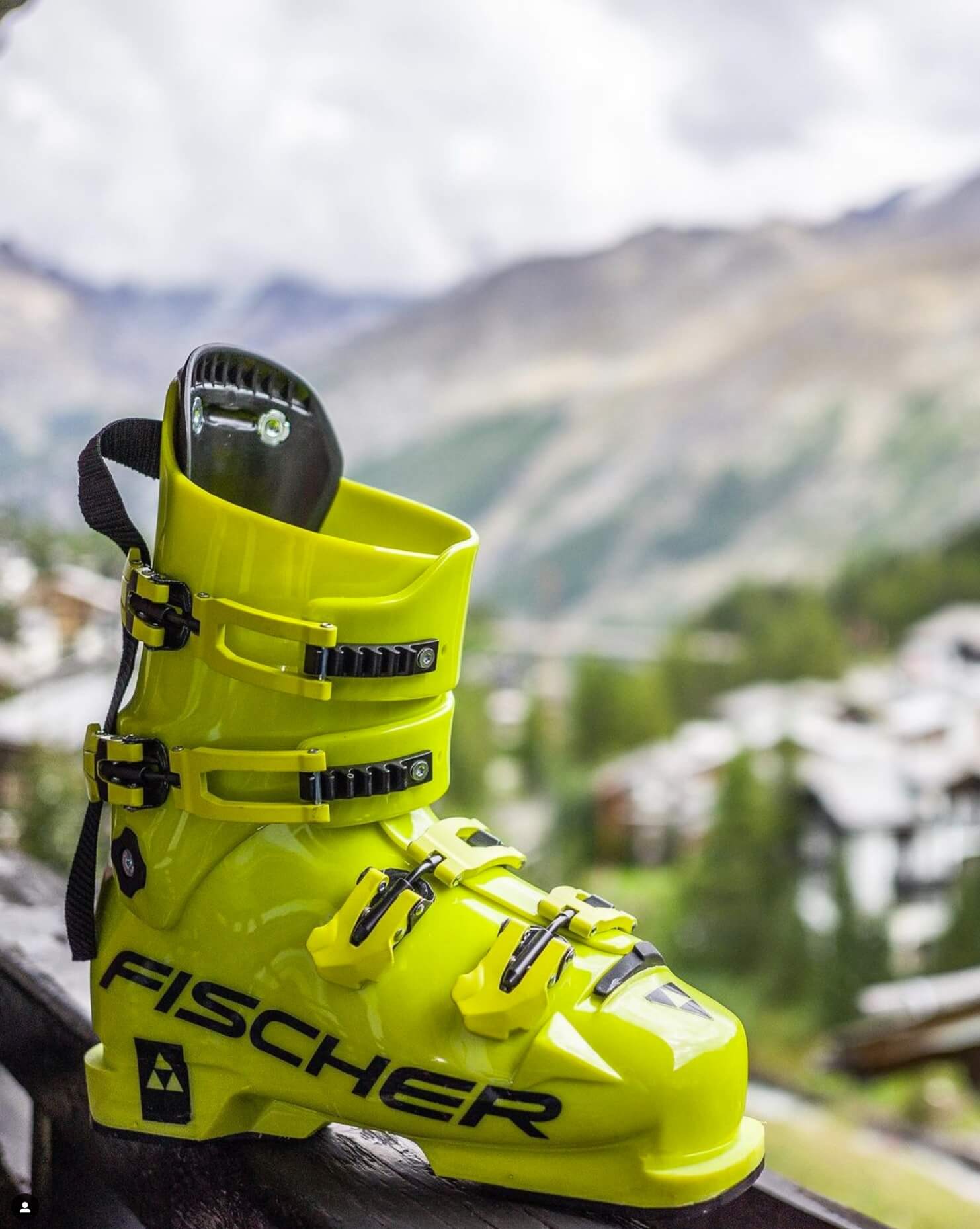
Conclusion
Forward lean in ski boots is a not well-known aspect of the setup, but it has a tremendous effect on how you perform and feel your skiing.
I recommend every skier to tinker a little bit with it and try different setups. Maybe you find high-forward lean setups something you love and cannot ski without… (like me 😉 )
Keep ripping some arcs!


Forward lean is only HALF the story. Those elite skiers that use high forward lean also tend to move their their binding mounting BACK. It is all about loading the ski properly. It is very possible to load the front of the ski too much.
I ski 93mm last Nordica ES Race boots. They are serious. For SL, I ski Rossi 165x12m FIS SL skis. With the bindings mounted in the standard location they are UNSKIABLE with the forward lean full spoiler in my boots. With the full spoiler in…the tips grab and hook uncontrollably. In addition, I can literally feel the tips of the skis fighting turn initiation. The tips want to “stand up” the ski. The stock Nordica spoilers are about 5/16″ thick. But with a custom spoiler about half the thickness however, I am in an amazing sweet spot and the skis just rip. At a high level of skiing, the difference between “just the right forward lean”…and “too much”, is dramatic. I suspect that if I moved the bindings back a bit on the FIS SLs, they would become ski able again.
It should also be noted that high level (FIS) skiers ski with a very long, barely bent outside leg to handle the immense loads. This means that when you increase forward lean, it has a proportionally greater effect on ski load distribution, because you are moving the whole body forward. The effect of forward lean for a high level racer is very different that for the average skier.
Thank you for your comment and for sharing your thoughts Thomas. I encourage skiers to tinker with it a bit and find the best setup for them. The difference of 1-2 degrees and the impact it can have on your skiing is really worth the try. Regarding the fore-aft position of the bindings, another sign of the bindings mounted “too much forward” on the ski is that you feel the tails of the skis engage and hook all the time, like trying to always carve, and makes it difficult to do skidded turns or even steer that tails of the skis. Cheers from Italy!
How does the binding being mounted too far forward increase both tip and tail engagement? That seems contradictory.
Hello Justin, great observation. Mounting the bindings more forward will load the shovel of the ski easier in the turn (that is when we pressure on the ball of our foot), so it produces “easier” turn initiations. On the cons side, it makes the ski a bit slower, on a racing course. The other disadvantage is that the tails become difficult to “release or disengage” in a turn. The “long” tail becomes a long lever that wants to engage and carve the whole time, particularly at the end of the turn, where we should have the pressure on the heels of our feet. To skid a turn becomes more difficult to perform.
It is a bit of trial and error, but when you mount it too far forward, you will feel this “tails disengaging difficulty” I’ve talked about. Cheers from Val Gardena, Italy!
This all very interesting. How can looking at Shiffrin’s set up help me as an intermediate skier? I have pretty good dorsiflexion and I am in 110 flex. When I get forward my knees are just about over my toes, not much further although I am trying to bend the boot. If I get in 100 flex I can almost put my knees 4 inches past the front of the binding. Should my knees go PAST my toes?
Hello Matthew, thanks for the comment. Going down in flex to drive your knee even further forward is not what to look for. We need strong support on the front part of the boot to transmit the load into the skis shovel/tip. Going down in flex does not make it (actually does the opposite). My advice would be to stay with the 110 flex, but tinker with the velcro rear spoiler (if your liner has it). Put it if you do not use it, or move it a 1-2 centimeters down if you are using a rear spoiler already. And go skiing. Tinker with it a bit. You will feel the difference, and maybe you’ll love it. Cheers from Italy and soon Bariloche, Patagonia Argentina!
I agree 100% with your perspective
In my opinion get your knees over toes to start
if limited dorsiflexion heel lifts to achieve leaving some ROM
establishing YOUR dorsiflexion has variables femur to tibia length ratio, torso/leg length etc
once you have dialed it in for your specific anatomy it is golden your progression in the sport can be leaps and bounds
Establishing correct forward lean and boot flex for me was amazing
Thank you for your comment Greg. I agree, forward lean angle can make skiing an amazing activity or a really difficult one… 3-4 degrees can change everything… So I strongly encourage skiers to tinker with it, until they find the setup they prefer. Cheers from Italy!
Nowadays upright boots are seriously veirdos. If you stay straight, and you boots act against any flex with your knee. As experiment try to jump with straight feet. No can do, you have to go down first to have something where jump from. And you you stay upright, then you ski with heels, and heels are back from the middle of the ski. So you cannot pressure the middle of thes ski in carving. And thta pressure, how to make that pressure without any bent knee? 😉 One never mentioned thing: If you have forward lean, and so angled knees, if your ski grabs snow and turns rapidly side, what happens (if your bindins are too tight, as many have) You whole leg turns from your hip, and that is plento ok, if we compare to the other one: straight leg, then in same accident you are turning your darn knee. I’d not want that to happen to my precious knee! Lastly: I know we are not in 1980s when you pressurised the forwar ski to get it bent and turning, nowadays houglasses goes to turn when tilted to turn, jus pressing the middle of the ski…but not with presuring the rears with your heel, as majority do, and manufaturers clap their hands…oh, this is so relaxing!
Thanks a lot for the feedback Ocku! it is greatly appreciatted. Come to ski the Italian Alps this season! Cheers!
And want to add on my comment that this, actually good writing lacks something, the picture of measuring forward lean is not accurate, as many boots you cannot alter the actual boots lean, only put there inside those mentioned shims, so the outer lean stays, but real lean alters. But, there is no standardized method for measure that lean, or actually anything in these shoes, even the flex is numbered like big joke. And on many articles there is saying that if add shim under yopu heel, it adds lean, but it does not. If woman adds heels, she still is upright and has upright legs. Thee bots upper “tube” says what the leaning is, and it is just the same, whever if lower of higher your heel.
Hello Ocku, thanks for the feedback. Yes, you are right. There is no standarized or accurate way to meassure forward lean in boots, and it is impossible to perform a correct comparison among different brands. We have some rough numbers, and then it is more of a try and error method, a tinkering process basically. It is a shame because one degree change on the forward lean on your setup and it becomes a completely different sport. The difference in turn initiation particularly on the steeps, is huge. That’s why I encourage skiers to tinker a bit with forward lean angles, particularly adding the rear spoiler on the liner. Thanks again, and keep ripping some nice arcs!
Thanks for your article. I find that boot fitters try to discourage me from an “aggressive”forward lean. Yet time after time I have to shim the backs and loosen the top buckles to ski steeps and bumps. It’s a bad compromise as I’m losing the connection to the ski that I need. Im a male skier, 150 lbs and mistakenly chased a softer flex to get the knee angle I need. I’m finding that I now have a bad tendency to throw my upper body too far forward in an attempt to regain that balance point and avoid falling back on the skis. Are there boot shells that offer a more aggressive forward lean? Or, besides a shim or heal lift, are there ways to deconstruct the cuff and adjust it to that angle I like?
Hello Bob, thanks for your comment. I understand what you talk about. I’ve seen that problem in a lot of my students, from intermediate and even to very advanced ones. Yes, definitely, you should get a more agressive forward lean cuff, like the race plug boots of Fischer (RC4 podium RD) and or Atomic (Redster CS or STI). One thing, lifting the heel, does not increase forward lean, it increases the ramp angle with very different implications thank increasing the forward lean. Please feel free to contact me through whatsapp or emai, so I can help you better. Cheers from Cortina d’Ampezzo!
Fede, i am recreational skier since 2018 (only about 14 days per season). Now I am 53 years old but I love it…I was problem with knee varus. I performed the procedure canting my ski boots. Now I think about my optimal forward lean (I have good dorsiflexion). Maybe do you have sugestion about apprioprate degrees?
Hello Paul, thanks for your comment. It is really difficult and unprofessional to guess and recommend what forward lean angle you should use, without seeing you and checking several different parameters. What I do recommend is that you experiment a bit. Add some rear spoilers to the liners of your ski boots and go ski them. You will feel right away if that forward lean increase helps you or not. If you can pressure the front part of the skis easier, particularly in the steeps, it is the way to go. Tinker with it a bit. You will be surprised about the huge changes you get in your skiing with little changes on your ski gear setup. Cheers from Argentina!